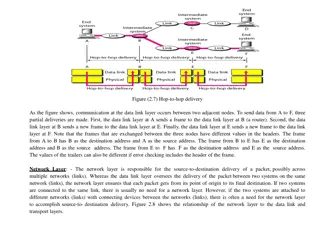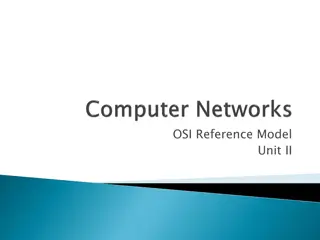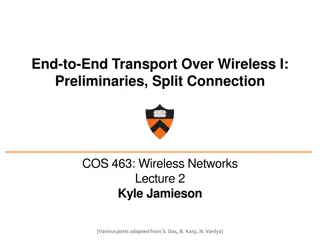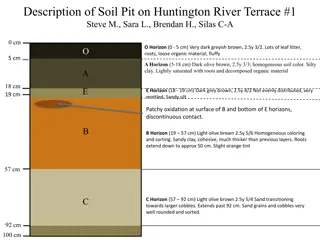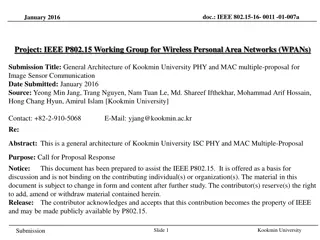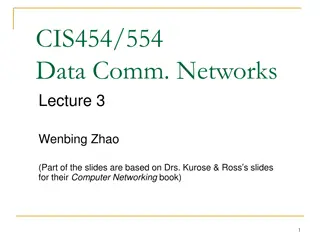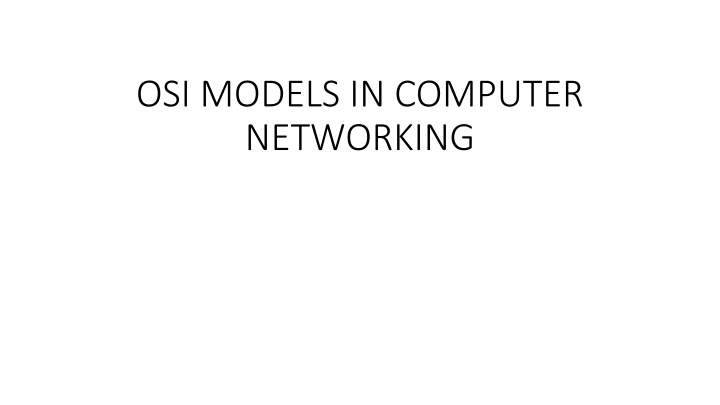
OSI Model for Effective Networking
Explore the OSI model in computer networking, designed to facilitate seamless communication among diverse systems while preserving existing hardware and software logic. Learn about the model's principles, layers, and how data flows through encapsulation and decapsulation. Dive into the purpose and workings of the OSI model to grasp its significance in modern networking.
Download Presentation

Please find below an Image/Link to download the presentation.
The content on the website is provided AS IS for your information and personal use only. It may not be sold, licensed, or shared on other websites without obtaining consent from the author. If you encounter any issues during the download, it is possible that the publisher has removed the file from their server.
You are allowed to download the files provided on this website for personal or commercial use, subject to the condition that they are used lawfully. All files are the property of their respective owners.
The content on the website is provided AS IS for your information and personal use only. It may not be sold, licensed, or shared on other websites without obtaining consent from the author.
E N D
Presentation Transcript
OSI MODELS IN COMPUTER NETWORKING
Purpose of os! The aim of OSI model is to open communication between different systems without requiring changes to the logic of the existing hardware and software.
Principles Principles of OSI of OSI Each layer should perform a well-defined function The layer boundries should be chosen to minimize flow across the interfaces
Brief Explanation of OSI Model The Open Systems Interconnection model (OSI model) is a conceptual model that describes the universal standard of communication functions.[1] Standardized in 1983 by ISO as OSI 7498[2] and ITU as X.200[3] OSI model is based on seven encapsulating layers to abstract different task from each other. 7 Application Layer End-user software, protocols 6 Presentation Layer Prepare data 5 Session Layer Create communication channel Connection establishment Flow control, match connection speed, error control, Split / reassemble packets. 4 Transport Layer 3 Network Layer Perform best End to End (ETE) path routing. 2 Datalink Layers Establish / terminate 1 hop connection. Consist of LLC and MAC 1 Physical Layer Cabled or wireless, electrical characteristics 08.05.2022 EE531- Computer Network Design Techniques 5
How does os model work? Data flow occurs between layers through Encapsulation & Decapsulation. When data is passed from application layer and moves downwards till physical layer then this process is called as Encapsulation . Decapsulation is exactly the reverse of this process. Layers cannot be skipped in this process
Seven layer Os layer modelng Application A Application B Peer-to-Peer Application Protocol Application Layer Application Layer Peer-to-Peer Presentation Protocol Presentation Layer Presentation Layer Peer-to-Peer Session Protocol Session Layer Session Layer Peer-to-Peer Transport Protocol Transport Layer Transport Layer Network Layer Network Layer Network Layer Network Layer Data Link Layer Data Link Layer Data Link Layer Data Link Layer Physical Layer Physical Layer Physical Layer Physical Layer Communication Network Subnet Roundry
Relationship Between Each Layer APDU Application protocol data unit. PPDU Presentation protocol data unit. SPDU Session protocol data unit. TPDU Transport protocol data unit (Segment). Packet Network layer host-router protocol. Frame Data-link layer host-router protocol. Bits Physical layer host-router protocol.
Upper and lower layers We can also divide these 7 layers into two major groups: Lower/Media Layers (Layer 1-4) deal with networking. They layers mainly handle data transport issues. These layers are implemented in both hardware and software. Upper/Host layers (Layer 5-7) are mainly responsible for dealing with applications.
Os protocols Every layer of OSI Model has some protocols associated with it. For example, DNS is a protocol which is used for naming of domains and it belongs to application layer. Below are some of the protocols associated with each layer:
Why Why is OSI an is OSI an Important Important Model? Model? Although the modern Internet doesn t strictly follow the OSI Model the OSI Model is still very useful for troubleshooting network problems.
OSI vs TCP/IP Application layer in TCP/IP model is combined with Presentation and Session Layers. Datalink and Physical layers are merged and named as Network Access Layer. Network Layer becomes Internet Layer. OSI Model Protocols TCP/IP Model 7 Application Layer TELNET DNS DHCP 6 Presentation Layer 4 Application Layer FTP SMTP HTTP NFS SNMP Others 5 Session Layer 4 Transport Layer 3 Transport Layer TCP UDP 3 Network Layer 2 Internet Layer IP 2 Datalink Layer ETHERNET TOKEN RING 1 Network Access Layer FRAME RELAY ATM 1 Physical Layer 08.05.2022 EE531- Computer Network Design Techniques 12
Network equipment at layers Load Balancers Firewalls Gateways Computers
Peer to peer process Within a single device, each layer uses The services provided by the layer just below it Provides services for the layer just abouve it Communication is made possible by using the peer to peer protocols approriate to that layer X. Physical layer 1 communication is direct device A sends a bit stream to machine B Header is the control data appended to the beginning of the data. Header are added at layers 2,3,4,5 and 6. Trailer is the control data appended to the beginning of the data. Trailer is added at layer 2. Layer 2 removes the data meant for it then passes the rest to layer 3 Layer 3 removes the data meant for it then passes the rest to layer 4 and so on like this




